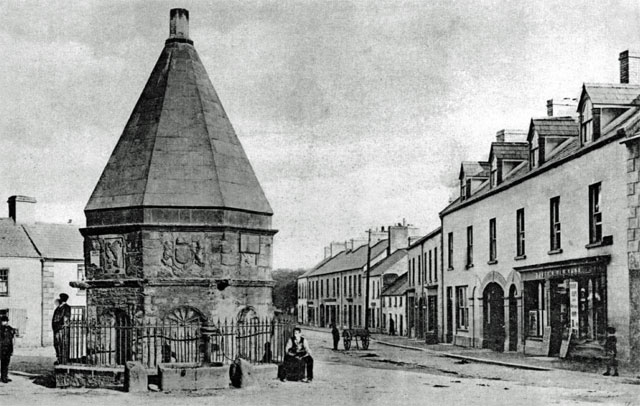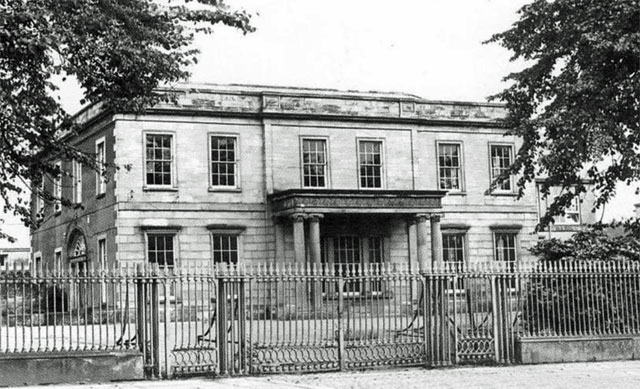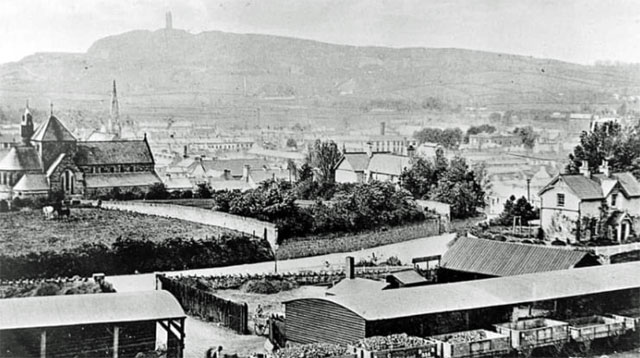The tour, organised by Ards & North Down U3A, was led by Brian McDonald, Chair of Newtownards Historical Society.
Newtownards and surrounding area have evidence of being inhabited both in the Megalithic and Neolithic times. Finnian founded Movilla Monastery in 540. St Columba or Colmcille trained under St Finnian, most likely of Movilla. Columba founded a monastery in Iona and from there went on to evangelise Scotland.
King Henry II granted John de Courcy, an Anglo-Norman knight, Ulster if he could conquer it. In 1177 De Courcy invaded Ulster and consolidated his conquest by settling the families of his followers in the area, among whom were the Savages. In the early 1200s the town of Newtown or as the Normans called it Nove Ville de Blathewyc was founded. The earldom of Ulster had been divided into counties one of which was Blathewyc which covered North Down. In 1216 a new order of preachers called the Dominicans was established. The prominent Anglo-Norman family, the Savages, acted as sponsors for the Dominicans which led to the establishment of the Dominican Priory in Nove Ville de Blathewyc in 1244 which was dedicated to St Columba.
There was a decline in the Earldom of Ulster in 14th century, but the Normans still held Carrickfergus Castle and surrounding area. One of the reasons may have been the black Death of 1348-9 when one third to one half of the population of Europe perished. The Clan Aedhe Buidhe (Clan of Yellow Haired Hugh) migrated east of the Bann in the 14th century. The dissolution of the monasteries of North Down under Henry VIII occurred in 1542. However, the former 'spiritual lands’ of North Down ended up being controlled by the Clan Aedhe Buidhe. Queen Elizabeth granted the North Down area to her principal secretary Thomas Smyth in 1571. In 1572 Sir Brian MacPhelim O’Neill destroyed all the monastic buildings in North Down to prevent them being used as English garrisons. These included Movilla and the Priory in Newtownards.
By 1589 Con O’Neill was Lord of South Clannaboy. In early 1603 after an altercation between his men and some English soldiers, when one English soldier was killed, Con O’Neill was imprisoned in Carrickfergus Castle. Queen Elizabeth died on 24th March 1603 and James VI of Scotland became James 1 of England, but Con wasn’t released and was still imprisoned in Carrickfergus Castle. Through the help of Hugh Montgomery, the Laird of Braidstone, Con escaped from Carrickfergus Castle, hid for a few days in the tower of Bangor Abbey before heading for Scotland. Hugh Montgomery was to obtain a pardon for Con on the condition that he got half of Con’s lands. James Hamilton, spy for King James, heard about this. Con’s lands ended up being divided into three. James Hamilton’s new territory included Bangor, part of Comber, Killyleagh, Dundonald and some parts of the Ards Peninsula while Hugh Montgomery’s new territory included Newtownards, Donaghadee, part of Comber, Greyabbey and a large portion of the Ards Peninsula.
Hugh Montgomery arrived in what remained of Newtown in 1606 and initially lived in the old castle building or tower house. He ordered his men to set to work to repair the priory and by 1607 the chancel was turned into a church. A tower was also added to the building. Part of the old priory remains was made into a house for Hugh Montgomery. By 1611 a good town of 100 houses had been built, all peopled with Scots. The town was created a borough in 1613 with Montgomery as its Provost and he had the power to send two representatives to the Irish parliament in Dublin. As well as the Provost, 12 burgesses were drawn from a list supplied by Montgomery. These 12 burgesses along with the Provost constituted the Common Council of the Corporation. The setting up of a provost with 12 burgesses was to mirror Jesus and his 12 disciples.
 The Market Cross (from postcard in The Lawrence Collection)
The Market Cross (from postcard in The Lawrence Collection)
The market cross was built in 1636. The present conical top wasn’t part of the original cross. The original cross was less than 11 feet tall with a low door. Inside was the officer supervising the market which was held in that area. Some traders used to come across early in the morning from Scotland via Portpatrick to sell their wares at the market and then returned home via Donaghadee later on the same day. In 1641 the native Irish rose in rebellion. This merged with the English Civil War. Both Montgomery and Hamilton were Royalists. King Charles I was executed on 30th January 1649. Oliver Cromwell then came with his army to Ireland. The Commonwealth troops destroyed the Market Cross in 1653. However, it was restored in 1666. The new conical roof was then used as an office for the town’s night watchmen.
The Montgomery family sold the manor of Newtownards in 1675 to Robert Colvill of Mount Colvill, Co Antrim for £10,640. The Colvill family later sold it in 1744 to Alexander Stewart for £42,000. Alexander Stewart’s new land included Mount Pleasant which he renamed Mount Stewart. Alexander Stewart’s first house was situated where the NFU building is in High Street, Newtownards.
Alexander Stewart, like many of his family married an heiress, Mary Cowan. With her money a very extensive building programme began in Newtownards in the 1770s. An impressive new Market House was built in the space opened up by demolishing part of the north side of High Street. It is the largest Market House in Ireland. There had been plans for colonnades down each side with a covered walkway but this was never built. The square in front was named Conway Square after Alexander and Mary Stewart’s son, Robert’s first wife, Lady Sarah Frances Seymour-Conway, daughter of the Marquess of Hertford, whom he married in 1766.
Around the Market House a cruciform street plan was laid, with North Street being intersected by East and West Streets. South Street was built in the 1770s along the route to Comber. John Wesley, founder of Methodism visited Newtownards 11 times between 1758 and 1789. He had a poor opinion of the town maybe caused by all the demolitions and rebuilding. In 1773 he wrote ‘I went to dreary Newtown’. Robert Stewart’s first wife died in 1770 in childbirth. Frances Street was named after his second wife Frances Pratt, eldest daughter of the Earl of Camden, whom he married in 1775. Robert Stewart was created Baron Londonderry in 1789, in 1796 he was elevated to Earl of Londonderry and finally in 1816 he was created Marquess of Londonderry.
On the 9th June 1798 Col Stapleton, in charge of the Crown Forces in the Market House in Newtownards, led his men to meet the United Irishmen in Saintfield, leaving a small force behind in the Market House. However, they were ambushed outside Saintfield and retreated to Belfast. Meanwhile William Fox, officer in the United Irishmen, rode to Bangor and Donaghadee and managed to raise a force of 300. They rendezvoused at Movilla graveyard early on Sunday 10th June and launched an attack on the Market House and were dispersed by fire from the king’s troops. The rebels regrouped and marched across to Conlig for another assault on the Market House.
Meanwhile the little garrison stationed there, realising they would not be reinforced, fled to Belfast. So, the United Irishmen were able to take the town late afternoon without any opposition. They proclaimed the area’s independence from Britain and set up a Committee of Public safety based on the revolutionary French model. The United Irishmen were defeated a couple of days later at the battle of Ballynahinch on 13th June.
The 1st Marquess of Londonderry’s eldest son Robert, Lord Castlereagh, became the 2nd Marquis in 1821 but committed suicide the following year. He was succeeded by his half-brother Charles who was a soldier. When he died on 6th March 1854 a group of his admirers met to discuss building a memorial to him in Conway Square. In 1855 it was decided to erect a memorial on Scrabo and the design should be the subject of a competition. However, the design picked came fourth in the competition. It was by Charles Lanyon and it was chosen because his design came within the price range of £2,000.
In the end the tower constructed, from scrabo stone, cost £3,010. Not all the embellishment of the tower could be carried out due to lack of funds. It is said that it was erected by grateful tenants because of how their landlord had acted during the famine years. However, two thirds of the cost raised was by 98 individuals who were fellow gentry and personal friends of the Marquess. Only a minority of people connected to the estate contributed to the fund and the Marquess had been criticised during the famine for his lack of generosity.
 Regent House
Regent House
During the reign of King George III, the 1st Marquess of Londonderry invested money in the town. In 1817 a new road from Belfast to Newtownards via Bradshaw’s Brae was opened to serve the traffic of mail and passenger coaches on their way to Scotland and England via Donaghadee and Portpatrick. Regent Street, called after the Prince Regent, and Frances Street were developed at that time and they connected up to the road to Donaghadee. Regent Street and Frances Street are broad straight roads which use open space to give a sense of grandeur.
Peter Johnston, the local brewer built a grand house on Regent Street in 1820 called Regent House. Unfortunately, it is now much mutilated but there is a fine Georgian door complete with fanlight on the left side of the building. A school later opened in the building, hence the name Regent House School. Later the building was a car showroom. Peter Johnston’s brewery was situated on Regent Street at the corner of Brewer’s Lane. Later in 1884 Stevenson, Ledgerwood & Co. built a red brick factory on the site of the former brewery. They produced hosiery and skirts. The building is still there and is the only factory building remaining in the town.
In the 1700s a linen factory was opened in Newtownards by James Bradshaw. By the early 1800s a cotton mill was opened in the town. While cotton could be spun by steam engines the weaving was unmechanised. This provided a lot of work for the hand loom weavers in the town. However, during the American Civil War, the supply of raw cotton dried up putting the hand loom weavers out of work. Relief work was provided by the weavers building a path from where the Strangford Arms Hotel is now situated to where the FE College is now situated. The former was the site of the Newtownards Railway Station until it was relocated to the latter position in 1861 when the line was extended to Donaghadee. There were many factories and mills in Newtownards, but they faded away in the 1970s. Brian McDonald recalled that each factory’s starting hooter was unique. As a schoolboy he used to wait until one particular one sounded and then he knew it was time to get up for school.
A new Church of Ireland church was built in 1817. Why was it called St Mark’s? Perhaps because the rector at the time it was built was called Rev Mark Cassidy.
 Taken from the Railway Station and showing the new St Patrick's Church
Taken from the Railway Station and showing the new St Patrick's Church
By 1870s the old St Patrick’s Church in Ann Street was not large enough for the growing Catholic population of the town. The Dowager 4th Marchioness of Londonderry had become a Catholic. She offered to fully finance the building of a new church. The Marchioness asked Joseph Hansom to design the new church. He had been the architect for the newly completed Our Lady and St Philip Church, Arundel which had been commissioned by the Duke of Norfolk. St Patrick’s is like a miniature version of the cathedral in Arundel. Joseph Hansom was also the designer of the Hansom cab. The new St Patrick’s Church was dedicated in 1877.
The Poor Law Act for Ireland was passed on 31 July 1838 which divided Ireland into Unions which were composed of electoral divisions. There was a Board of Guardians for each Union. There was to be a workhouse in every union into which anyone seeking assistance would have to go. It was funded from rates levied on the property owners in each union. There were initially 130 workhouses built in Ireland which were up and running in the 1840s. The new Newtownards Union workhouse, designed to accommodate 600 paupers, was erected in 1841 on a site of just over eight acres at the west of Newtownards, between Church Street and Frederick Street. This building later became Ards Hospital. The Newtownards Poor Law Union stretched to Ballygowan and Moneyreagh in one direction, Kircubbin, Ballyhalbert, Bangor and Donaghadee in others. During the Potato Famine the numbers in the Workhouse rose to over 800. Sheds and sleeping galleries had to be erected to accommodate an additional 200 inmates.
The Ards TT racing was a very popular event which began in 1928. It started from Quarry Corner, outside Dundonald. The cars approached Newtownards from Bradshaw’s Brae and entered the town at Church Street, passed along Regent Street and then turned into Conway Square. They were held up to 1936 when a local driver lost control of his car and clipped a long line of spectators near the hospital, killing 8 and injuring 40.
For further information on Newtownards see Newtown, a history of Newtownards by Trevor McCavery.
